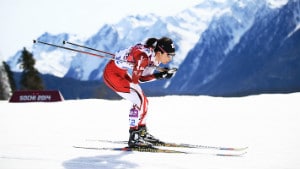
Last week Matt Graham won the first medal for Australia at this year’s Winter Olympics in freestyle skiing. If you were watching his silver medal performance you would’ve seen him speeding down a steep slope, darting through series of bumps at a break-neck pace and throwing in an aerial flip or two while he’s at it. How crazy exciting was that?!
Cross country skiing on the other hand….

(Source: Official Olympic Games website)
Going uphill? That looks like a whole lot of hard work! That’s why cross-country skiers are some of the fittest athletes in the Olympic games. Want to know how they train their bodies to its optimum fitness and endurance? Check out this video about the process an Olympic athlete undergoes in order to improve their body’s efficiency of converting oxygen into energy via cellular respiration!
Skiing evolved from a necessary means to get around, to a recreational and competitive sport. Imagine how tedious it would be to try and walk or ride a horse in the knee-deep snow! The word ‘ski’ comes from ‘skid’, in Old Norse it translates to ‘sticks of wood’, which is exactly how the Scandinavians have been travelling on snow since thousands of years ago. In the 1600’s and 1700’s, there was even record of their military troops fitted with skis and trained with ski exercises to cover great distances quickly during winter times. Today, the remnant of this practice can be seen in the biathlon event, where athletes cross-country ski as well as shoot at targets with their rifles that they have to carry on their backs!

(Source: Olympic Channel website)
There’s plenty of science at play:
- On an incline, the athlete is using their arms and legs and every other muscle in order to move uphill, turning chemical potential energy from their bodies into kinetic energy. The kinetic energy is then converted into gravitational potential energy as the skier moves up the hill.
- At the top of the hill, all that stored potential energy is at its peak. When the athlete moves downhill, the potential energy converts back to kinetic energy, which increases as they speed down the slope so they don’t have to work as hard.
- Here’s a great video explaining the different techniques in cross country skiing and the forces involved:
When the terrain changes from uphill to downhill, you will often see the athlete adopt a completely different body position. They tend to keep their body as small as possible by bending the knees, tucking the arms into their centre and their head down. This is to reduce air resistance so they can conserve as much kinetic energy as possible to avoid slowing down.

(Source: Olympic Channel website)
Historically, skis are made from wood. In modern times, fibreglass is the main material that skis are made from. Fibreglass is produced by encasing glass fibres in a polymer, like epoxy or resin. With different arrangements of the fibres, ski makers can actually tune the rigidity of the skis! This is very useful since different events require skis with a different amount of flex.
Most skis require regular waxing. Athletes already have a lot to battle with during the race; the smooth and hydrophobic wax on the bottom of the skis will make their lives a little easier by reducing contact and rubbing against the snow, or friction. But different weather and snow conditions might cause the wax to harden or soften. Too hard, the skis will have a high coefficient of friction and grip too much. Too soft, ice crystals might penetrate the wax and cause more ice to form and stick to the skis. This is why the Olympic teams have a whole squad of technicians dedicated to deciding which wax to use for an event on a specific day and applying it correctly.
For classic skis, there is a ‘grip zone’ on the underside, just below the athlete’s foot. Its function is to help the athlete gain traction and in the old days, animal furs would be used for this job. You know how when you are patting a dog or a cat, in one direction it feels nice and smooth but and in the other it’s rough? This direction-dependent increase in friction is what allows the athlete to glide forward easily, without slipping backwards! To achieve a similar effect modern skis either have fish-scale patterns in the grip zone or more recently a patch of rubber that can be sanded to produce tiny little hairs to mimic animal fur!
For more Winter Olympics science, watch this space over the course of the games!
Happy teaching,
Learn more about ‘Forces, Friction and Movement’ with the Fizzics team!

NEW Primary science teaching book!
“Be Amazing! How to teach science, the way primary kids love”



























Comments